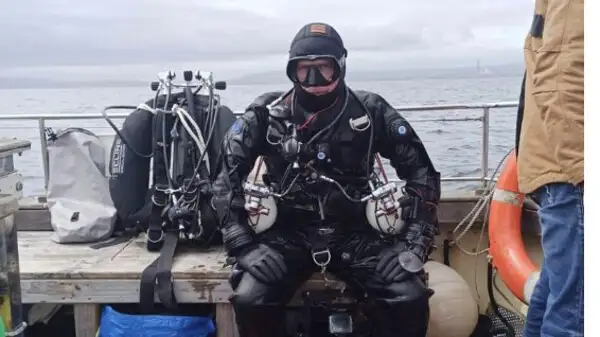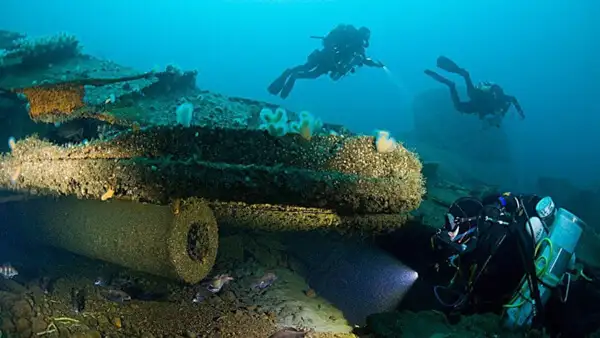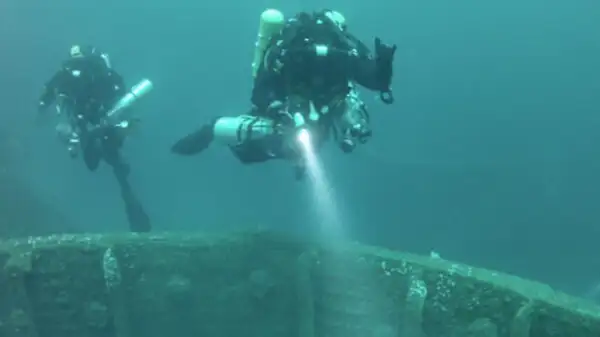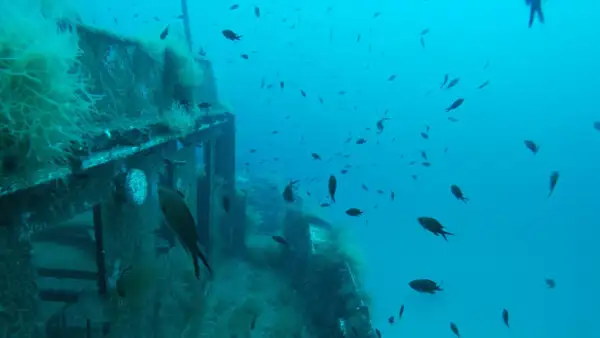Probably each of us scuba divers has already dived one or more wrecks without thinking much about it.
The dive boat from the resort takes you there, short briefing, dive down, look at it, surface, done.
And the next dive is about corals again.
Page Contents (click line to jump the text)

Intro
Wreck seen by the way, checked off, – yes, was quite nice!
Real wreck divers are much more serious about it!
On the one hand, wrecks are often located in depths that are borderline for recreational divers. On the other hand, wreck diving has some challenges and also dangers that you should know about.
And besides, it’s nice if you can learn a little more about the ship and its history. The experience just becomes more impressive that way.
It is even more impressive if you can spend a whole dive trip wreck diving. What do you need? Enough good wrecks at the right depth and a dive center that knows how to do it!
A mecca for passionate wreck divers is Ireland, because there are more wrecks here than anywhere else in Europe!
Have a look at this video on YouTube to get in the mood: Deep wrecks of Malin Head, Ireland, by Jesper Blomqvist Rydström.
By the way, we live in Ireland (second home) for many years now, coming from Germany. We have traveled the island again and again over many years and therefore know it very well.
Hundreds of wrecks off the Irish coast
The title is not an exaggeration, but actually an understatement. In fact, there are over 4000 shipwrecks off Ireland’s coasts. Many of them, however, at depths inaccessible to divers. But a few hundred of them can be dived.
From Viking boats, Spanish galleys, several fishing boats, the sailing ships of the English navy, Irish cargo sailing ships, steam passenger ships of the 19th century to the warships and submarines of World War I and II – the waters around Ireland have swallowed many ships.
Often it was simply the stormy seas, an unknown shoal, a reef, or other unfortunate circumstances. Very often, however, they were helped along, especially during World War I and World War II. Especially the northern tip of Ireland witnessed many warlike conflicts. Off Malin Head alone there are over 200 shipwrecks, most of them from the two world wars.

Wrecks for recreational divers
For recreational divers, the wrecks usually end at a depth of about 30 meters, with a maximum of 40 meters. But don’t worry, there is probably hardly in dive center in Ireland which can’t offer some wrecks down to 30 meters. Some nice examples:
The MV Kowloon Bridge is with about 290 meters one of the biggest shipwrecks in Europe and probably also the heaviest. It is an ore freighter that sank just offshore in Bantry Bay in 1986. It lies at an angle on the seabed and the higher parts start at only about 7 meters deep, the deeper parts are much deeper to just under 40 meters.
The Julia T is a much smaller cargo ship at 30 meters long. She supplied the islanders of Inishturk and Inishbofin off the west coast with building materials and other supplies until the 1980s.
Today, she lies upright at 27 meters at the bottom of Killary Fjord, or Killary Harbours, the only true fjord in Ireland. There is little current in the sheltered bay and so the Julia T is not difficult to dive.
It is covered all over with sea anameons, which makes it a particularly nice dive destination. There is a nice short YouTube movie about this: Diving the Julia T Wreck at Killary Fjord, Ireland by Diving Squad.
The HMS Wasp off Tory Island on the coast of Donegal sank already in 1884. It lies in only 15 meters depth. Two cannons are still visible.
The USS Quebra off the Blasket Islands ran aground on rocks in 1916 and sank. She is about 120 meters long and lies at a depth of about 15-30 meters.
The MV William Manell was a minesweeper. Ironically, she sank herself – sunk by a sea mine in WW1. She now lies at a depth of 30 meters in Culdaff Bay in Donegal.
The SS Castle Eden also lies in Culdaff Bay. The freighter was sunk in WW1 and lies today at a depth of 32 meters (a little over 30 meters – I know).
There are many more examples – but that is beyond the scope of this article.
Wrecks for Tec divers
For Tec divers it really starts from 30-40 meters and that’s good, because they have of course an enormous choice of great wrecks. Alone at Malin Head, but also at other places. See also the Youtrube movie: Wreck Diving the Malin Head ‘classics’ 2019 by Kieran Hatton.
The U 260 is a WW2 German submarine that was sunk by a mine off Baltimore. The crew managed to escape in inflatable boats and the submarine then sank to a depth of about 44 meters. It is still mostly intact and nicely covered with sea anemones and sea lilies. There is a movie about this on Yutube: Wreckdive at U260 at Baltimore by Tauhausflug.eu.
The RMS Laurentic is one of the classics off the northern tip of Ireland. Off Lough Swilly the big freighter lies in 40 meters depth after she was sunk in WW1 – also by a mine. See also: The SS Laurentic – Wreck Dive, Donegal, Ireland 2014 HD720 by alanph1.
The Empire Heritage lies much deeper, at a depth of 65 meters. She is a large tanker from the 2nd world war.
The Justica is also at a depth of 65 meters. She belonged to the famous White Star Line and was torpedoed in 1918. Who is the White Star Line? The British shipping company owned. Among others, the Titanic and its sister ships.
The Audacious is a battleship that was sunk in World War 1. Today it lies at a depth of 65 meters and is also a diving highlight because of the many marine life on the wreck.
The Cumberland is a freighter that was sunk in WW2 and lies at a depth of 50 meters.
There are also many more wrecks you can dive. This was just a small taste!

Is wreck diving off Ireland dangerous? What should you know?
Wreck diving doesn’t have to be dangerous, but it can be – I know that doesn’t help at all – so let’s go into a little more detail:
If you look at a wreck in calm conditions at moderate depth, dive around it once and don’t touch anything, it’s not dangerous for now.
If the wreck is a little deeper, you can quickly dive too deep, exceed your bottom time, or even get a depth rush.
Currents or swells can make your dive much more difficult. Exiting the boat and re-entering will be much more difficult. On the subject of swells, check out this YouTube video: WreckDiving in Donegal Ireland by Tauchsport Pape.
You can lose the bottom line and drift off and underwater it is much more difficult to tare in swells – you just drift up and down more. This can also cause you to accidentally hit the wreck and injure yourself or damage your equipment.
If you dive into the wreck without knowledge you can hurt yourself or damage your equipment on sharp metal parts – stupid if it was the hose from the regulator!
Also, you can get lost in dark wrecks and not find your way out – the wreck is like a cave.
Is that supposed to scare you? No! You can learn many things that will make your wreck diving safer and more enjoyable! We’ll get to that now:
Additional training for recreational divers
Probably you did your first diving course as a PADI Open Water Diver, or a comparable Open Water Diver? Then have a look at the website of PADI or your diving organization to see what other courses they offer.
The following PADI courses make a lot of sense for recreational wreck diving in Ireland:
For the Advanced Open Water Diver you can choose from 5 modules. The specialties Boat Diving, Deep Diving and Navigation are super helpful, as well as Buoyancy (Peak Performance Boyancy and Wreck Diver. This will give you a taste. You can deepen each of the specialties with additional courses.
With the Deep Diver you expand your skills to dive safely down to 40 meters (OWD = 18 meters, AOWD = 30 meters).
In the Wreck Diver you will learn to use lines and reels, safely enter the interior of a wreck, and you will learn fin stroke techniques that will help you stir up less sediment or move in tighter spaces.
With the Dry Suit Diver you learn how to use a dry suit, which is also a buoyancy compensator and backup to your buoyancy compensator vest (BCD or Wing). It also helps you to dive with pleasure in cooler waters, for example in Ireland.

The Self Reliant Diver teaches you to dive alone, including dive planning, navigation, maskless diving, buoy setting and redundant gas systems.
Diving alone, really? That’s a no-no!
It’s great if you have a good buddy you know and can trust on the dive. But the reality at many vacation dive centers is that you get assigned some buddy. Good if he is experienced, reliable and prudent. But often this is not the case and then the buddy can even increase your diving risk.
I have experienced both cases many times and then dived more and more often with my own equipment and without a dive group. In deep and often dark cold water, with dry suit and wing jacket, double tanks with redundant regulators, two masks, two computers, two lights, reels and buoy etc.. Left to my own devices and focused like that, I often felt safer than with unknown buddies.
At that time I was often criticized by other recreational divers for diving alone, today you can even do a PADI course on it – I think it’s great!
Why should you? It makes you more independent and safer, even if your buddy suddenly drops off or gets “lost”.
Why Tec diving also helps the recreational diver
Tec diving can be dangerous if you push your limits. So can recreational divers. However, the risk potentially increases with Tec diving because you can no longer simply surface without decompression to solve your problems. Tec divers measure their problems underwater and keep their deco times.
But hand on heart: How many vacation divers with OWD-brevet (up to 18m) do a wreck dive on 36 meters on vacation to then just barely hang out the safety stop with a completely sucked out 10-liter tank? Who of them would have had a plan B in case of a sudden problem? Exactly!
That’s what Tec diving is all about: Learning techniques to dive deeper more safely. You also learn to plan for typical problems and execute solutions underwater. You’ll learn how to use Nitrox to extend your bottom time or plan safe deco dives, and you’ll learn how to manage the risk of depth rush and reach greater depths more safely with Trimix. You will also learn to design and optimize your equipment for redundancy.
If you learn to dive more safely with compressed air to 30 or 40 meters in the first step, you are already much further than most. You can do this for example in the PADI courses Discover Technical Diving and Tec 40.

Instructors for technical diving and wreck diving in Ireland
You can also do or complete your diving education abroad. For example, I did my OWD in Venezuela and my AOWD in Tenerife (the rest then in Germany).
If you want to learn wreck diving in Ireland, why not learn wreck and technical diving there? I have researched the following addresses for you:
WreckDiving is an IANTD training center in Dublin. Red Fins is part of it and focuses on wreck diving with side mounts.
Mevagh Diving is a PADI Dive Centre that specializes in wrecks and wreck diving.
South West Technical Diving offers training according to IANTD.
Virtually all PADI Divecentres in Ireland offer the specialties of dry suit diving, deep diving, wreck diving and orientation. Some also offer advanced Tec courses.
What’s next?
Yes and where can you go wreck diving in Ireland now? An article about dive centers in Ireland is linked below. In principle, most bases also offer wreck diving, just call and ask.
A specialist for technical wreck diving at Malin Head is Mevagh Dive Centre. Again, as always in Ireland, just call.
Otherwise you can book a nice course with wreck excursions at one of the PADI dive schools in Ireland.
I wish you many great wrecks and a great diving trip to Ireland!
More interesting articles for you
TIPS FOR (NON-DIVING) DIVERS AND OTHER MARINE ENTHUSIASTS IN IRELAND
WHAT TO SEE ON A DIVE IN IRELAND – MARINE LIFE OFF IRELAND’S COASTS
THE BEST EQUIPMENT FOR A DIVING VACATION IN IRELAND
Photo credits cover image: Photo by NOAA on Unsplash